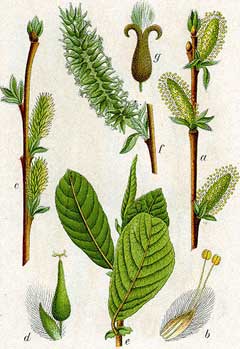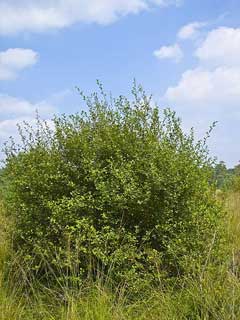 |
|
http://commons.wikimedia.org/wiki/File:Salix_aurita_Sturm26.jpg |
 |
|
Translate this page:
Summary
Physical Characteristics

 Salix_aurita is a deciduous Shrub growing to 2.5 m (8ft 2in).
Salix_aurita is a deciduous Shrub growing to 2.5 m (8ft 2in).
See above for USDA hardiness. It is hardy to UK zone 5 and is not frost tender. It is in flower in April, and the seeds ripen from May to June. The species is dioecious (individual flowers are either male or female, but only one sex is to be found on any one plant so both male and female plants must be grown if seed is required). and is pollinated by Bees. The plant is not self-fertile.
Suitable for: light (sandy), medium (loamy) and heavy (clay) soils and can grow in heavy clay and nutritionally poor soils. Suitable pH: mildly acid and neutral soils. It cannot grow in the shade. It prefers dry moist or wet soil.
UK Hardiness Map
US Hardiness Map
Synonyms
Plant Habitats
Edible Uses
References More on Edible Uses
Medicinal Uses
Plants For A Future can not take any responsibility for any adverse effects from the use of plants. Always seek advice from a professional before using a plant medicinally.
The fresh bark of all members of this genus contains salicin[226], which probably decomposes into salicylic acid (closely related to aspirin) in the human body[213]. This is used as an anodyne and febrifuge[226].
References More on Medicinal Uses
The Bookshop: Edible Plant Books
Our Latest books on Perennial Plants For Food Forests and Permaculture Gardens in paperback or digital formats.

Edible Tropical Plants
Food Forest Plants for Hotter Conditions: 250+ Plants For Tropical Food Forests & Permaculture Gardens.
More

Edible Temperate Plants
Plants for Your Food Forest: 500 Plants for Temperate Food Forests & Permaculture Gardens.
More

More Books
PFAF have eight books available in paperback and digital formats. Browse the shop for more information.
Shop Now
Other Uses
Plants have an extensive root system and are used to stabilize waste tips and old slag heaps[199]. The seeds are very light and so can travel some distance in the wind. The plant is therefore able to find its way to areas such as cleared woodland where the soil has been disturbed. Seedlings will grow away quickly, even in exposed conditions and the plant will provide good shelter for the establishment of woodland plants. Thus it makes a good pioneer species and, except in wetter and moorland-type soils, will eventually be largely out-competed by the other woodland trees. Its main disadvantage as a pioneer plant is that it has an extensive root system and is quite a greedy plant, thus it will not help as much in enriching the soil for the other woodland plants as other pioneer species such as the alders, Alnus species[K]. Dynamic accumulator.
Special Uses
References More on Other Uses
Cultivation details
Succeeds in most soils, including wet, ill-drained or intermittently flooded soils[1, 11], but prefers a damp, heavy soil in a sunny position[200]. Rarely thrives on chalk[200]. Thriving in the most adverse conditions, it is a useful plant for populating dry barren sites[199]. Closely related to S. caprea and S. cinerea[11]. Hybridizes freely with other members of this genus[200]. Although the flowers are produced in catkins early in the year, they are pollinated by bees and other insects rather than by the wind[11]. When inhaled near to, a scent of white jasmine can be discerned from the flowers[245]. Plants in this genus are notably susceptible to honey fungus[200]. Dioecious. Male and female plants must be grown if seed is required.
References Carbon Farming Information and Carbon Sequestration Information
Temperature Converter
Type a value in the Celsius field to convert the value to Fahrenheit:
Fahrenheit:
The PFAF Bookshop
Plants For A Future have a number of books available in paperback and digital form. Book titles include Edible Plants, Edible Perennials, Edible Trees,Edible Shrubs, Woodland Gardening, and Temperate Food Forest Plants. Our new book is Food Forest Plants For Hotter Conditions (Tropical and Sub-Tropical).
Shop Now
Plant Propagation
Seed - must be surface sown as soon as it is ripe in late spring. It has a very short viability, perhaps as little as a few days. Cuttings of mature wood of the current year's growth, November to February in a sheltered outdoor bed or planted straight into their permanent position and given a good weed-suppressing mulch. Plant into their permanent positions in the autumn. Cuttings of half-ripe wood, June to August in a frame.
Other Names
If available other names are mentioned here
Native Range
TEMPERATE ASIA: Russian Federation-Western Siberia (Western Siberia), Russian Federation-Eastern Siberia (Eastern Siberia) EUROPE: Denmark, Finland, United Kingdom, Ireland, Norway, Sweden, Austria, Belgium, Switzerland, Czech Republic, Germany, Hungary, Netherlands, Poland, Slovakia, Russian Federation (European part), Belarus, Estonia, Lithuania, Latvia, Ukraine (n. & w.), Albania, Bulgaria, Croatia, Italy (north), North Macedonia, Romania, Serbia, Slovenia, Spain (north), France (incl. Corsica)
Weed Potential
Right plant wrong place. We are currently updating this section.
Please note that a plant may be invasive in one area but may not in your area so it's worth checking.
Conservation Status
IUCN Red List of Threatened Plants Status :

Growth: S = slow M = medium F = fast. Soil: L = light (sandy) M = medium H = heavy (clay). pH: A = acid N = neutral B = basic (alkaline). Shade: F = full shade S = semi-shade N = no shade. Moisture: D = dry M = Moist We = wet Wa = water.
Now available:
Food Forest Plants for Mediterranean Conditions
350+ Perennial Plants For Mediterranean and Drier Food Forests and Permaculture Gardens.
[Paperback and eBook]
This is the third in Plants For A Future's series of plant guides for food forests tailored to
specific climate zones. Following volumes on temperate and tropical ecosystems, this book focuses
on species suited to Mediterranean conditions—regions with hot, dry summers and cool, wet winters,
often facing the added challenge of climate change.
Read More
Expert comment
Author
L.
Botanical References
1117200
Links / References
For a list of references used on this page please go here
Readers comment
| Add a comment |
|
If you have important information about this plant that may help other users please add a comment or link below. Only comments or links that are felt to be directly relevant to a plant will be included. If you think a comment/link or information contained on this page is inaccurate or misleading we would welcome your feedback at [email protected]. If you have questions about a plant please use the Forum on this website as we do not have the resources to answer questions ourselves.
* Please note: the comments by website users are not necessarily those held by PFAF and may give misleading or inaccurate information.
To leave a comment please Register or login here All comments need to be approved so will not appear immediately.
|
|